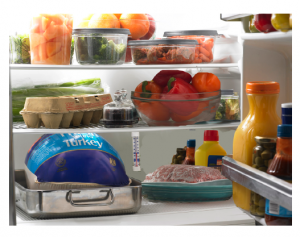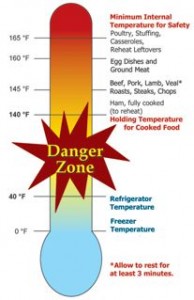
When a severe storm of the magnitude of Superstorm Sandy is predicted, one can’t stress enough that you need a plan of action to keep food safe, which starts before, is maintained during, and continues on after the storm has hit your area.
Unfortunately, it can be very trying to have to clean up after a severe storm has caused problems in your area when it comes to coping with power outages, flooding, and more.
Hopefully you have already downloaded A Consumer’s Guide to Food Safety Severe Storms and Hurricanes from USDA’s FSIS (Food Safety Information Service) and/or the version Keeping Food Safe During a Power Outage via the Department of Health, City of Columbus, Ohio.
(Image of interior of refrigerator from USDA/FSIS pdf Food Safety: Removing Odors from Refrigerators & Freezers).
Although the information can be found in USDA/FSIS & other government publications, in this Part 1 of 2 of this blog series we’ll provide a synopsis of the advisements put out by the USDA/FSIS (United States Department of Agriculture Food Safety Information Service) regarding keeping food safe in emergency situations such as severe storms and hurricanes, etc.
In Part 2 of 2 we’ll provide some additional explanation behind the recommendations made in those brochures and we’ll review additional suggestions from USDA/FSIS on removing obnoxious odors when food has spoiled in any refrigerator/freezer.
We strongly urge you to follow the most current advisements in any USDA/FSIS and other government produced brochures and any recommendations and advisements made by your local emergency management and health department, and any other government agencies working with the public where you are located. They are most familiar with the situation in your particular area.
The following is provided as infotainment only and is NOT meant to be a substitute for any federal, state, local, or not-for-profit emergency assistance provider in your area’s advisements–please be sure to follow the advisements provided to you by those entities with authority to provide public announcements and advisements specific to your locale.
Any refrigerator that is fully packed & tightly closed (you should have to tug to get a dollar bill to come lose if the gasketing had previously been closed on same and the gasketing is still optimally effective) will usually keep the temperature inside of it at or below 40°F for only up to a maximum time of 4 hours. Problems tend to occur after that when it comes to food safety issues resulting from power outages.
Once the temperature inside any refrigerator starts rising, the concern is for potentially hazardous food (PHF) items (explained below) to spoil due to more rapid growth of bacteria as the temperatures of those PHF items increases.
Completely full freezers can hold an acceptable temperature for up to 48 hours, while half-full freezers typically can only hold an acceptable temperature for up to 24 hours. Once ice crystals are melted in any food that was frozen, raw food items should be immediately cooked, since they are thawing then in an unpowered freezer (that previously could maintain ice crystals) which is now acting like an unpowered refrigerator for awhile.
Once temperatures inside a freezer rise above 40° F, the food safety clock swings into full gear and then after 2 hours have passed with the temperature being above 40° F in that freezer cavity, typically all raw & pre-cooked PHF items must be discarded if they have not already been cooked/reheated & eaten then & there, with the exception of, but not limited to, safe food items, which might include:
- breads (check for mold),
- coffees,
- hard cheeses,
- fruit juice concentrates or home prepared freezer pack frozen fruit (unless the items become slimy or develop a yeasty odor or mold colonies),
- nuts,
- spices (dry); yeast, (dry)
- vegetable juices after 6 hours instead of 2 hours.
If a working generator becomes available on-site before the 2 hour time window closes, it might be possible to save some items that still have ice crystals.
Once a storm comes to town and the power fails, some of the most potentially hazardous food (PHF) items in the refrigerator will be:
- cooked rice and cooked pasta;
- dairy products including custards and custard pies;
- processed foods containing beans, eggs, nuts, soy beans, soymilk or tofu;
- processed fruits and vegetables;
- raw meats and cooked meats;
- seafood;
- and then any combination of food items containing any of the above aforementioned PHF item sources.
 As a result, if any refrigerator’s temperature exceeds 40°F for more than 2 hours during a power outage, DISCARD any highly perishable PHF items, including, but not limited to the following mentioned in the USDA/FSIS materials on Keeping Food Safe During an Emergency.
As a result, if any refrigerator’s temperature exceeds 40°F for more than 2 hours during a power outage, DISCARD any highly perishable PHF items, including, but not limited to the following mentioned in the USDA/FSIS materials on Keeping Food Safe During an Emergency.
Remember that previous previous cooking or pasteurization will NOT be able to protect the food item from spoilage should the power fail and temperature inside your previous cold storage device rise into the temperature danger zone.
(Temperature Danger Zone graphic courtesy of USDA–go directly to the site via the hotlink to see a larger scale version of the graphic).
- Baby formula, opened
- Baked potatoes, cooked rice, cooked pasta
- Broth container, opened; gravy can, opened; creamy dressings/sauces (bottles), opened or homemade/deli purchased
- Canned, opened, high protein content food items such as fish, ham, meat and poultry
- Cold cuts, deli meats, lunch meats, dried chipped beef, bacon, hot dogs, sausage, sliced pepperoni, etc.
- Dairy products (includes milk & milk products, puddings, cheesecake/custard pies, pastries w/ cheese, etc.)
- Doughs, uncooked such as biscuit, bread, cookie, rolls
- Eggs, eggnog, egg salad and other salad mixtures including potato salad, macaroni salad, quiche, etc.
- Fresh cut fruits/vegetables; juices/fruits sold from store refrigerator sections; cooked vegetables; washed fresh greens
- Garlic, minced and other, stored in oil in opened jar in the refrigerator
- Leftovers, casseroles, convenience food combos, leftover take out, etc. containing PHF items including soups, stews
- Low fat margarine or spreads with dairy or other protein content
- Pizza with any type of perishable topping; opened jars of pizza sauce or pasta/spaghetti sauce
- Meat & Poultry of any type (except beef jerky as noted below)*, including any thawing meat, and especially any ground meat such as hamburger meat whether raw or cooked
- Seafood including fish of any type except canned fish that is in a sealed, unopened can; Fish sauces
- Stuffings
- Shredded & soft cheeses
- Tofu & soy product meat substitutes
The general advisement concerning opened containers of mayonnaise, tartar sauce and horseradish is that they should be discarded if they spend more than 8 hours above 50°F.
The more stable (less perishable) opened container, refrigerator stored, food items list that you could plan to salvage items from and if they are still safe, consume, includes, but is not limited to:
- Beef Jerky*
- Bread/breakfast food/cake category products (already baked products–monitor for mold)
- Butter/margarine, higher fat, salted
- Canned/jarred fruits that are preserved and sold from store unrefrigerated shelves; intact fresh fruits; dried fruits in resealable bags
- Fruit juices that are canned and sold from store unrefrigerated shelves; fruit pies already baked
- Grains, dry in closed packages; flour in closed packages, nuts in closed packages
- Hard cheeses, including grated versions that come in packaging (keep them as cold as you can)
- Jam, jellies or preserves made with sugar
- Ketchup
- Mustard
- Peanut butter (the natural type with oil on the top is most perishable of all types sold)
- Pickles, olives, other brined jarred items
- Steak/Taco sauces (commercial bottle, opened) such as BBQ sauces, Hoisin sauce, soy sauce, Worchestershire
- Sterile shelf milk (Brik Pak) and beverages, only if unopened
- Syrups
- Vegetables that are intact, including mushrooms
Although usually we’re big fans of a variety of fresh produce items, nonetheless, in the time period before, during, and after a storm, it can be prudent to zero in on making sure you have adequate supplies of properly packaged dried and canned/jarred options in preference to fresh ones.
Properly packaged dry and canned/jarred storage options simply will be better protected from contamination/spoilage than fresh ones will once a storm ravages any area. After a storm comes through, one has to make sure the seal on the container of any package, can or jar was not breached in any way by storm flood waters once storm surge waters subside.
Please be particularly alert if you are considering buying, washing and then consuming any fresh produce purchased AFTER such a superstorm hits an area (if the produce is from an area “Farmer’s Market”) unless you KNOW the farmers you are buying from. Why you ask? Because you want to be POSITIVE that it was not subject to undesirable contamination as a result of Superstorm Sandy coming through the area where it was grown/stored/transported.
Storm surges affected different spots within the huge swath of Superstorm Sandy. Additionally there have been concerns for problems with sewage lines and more causing contamination issues. There has also been contamination due to the horrific winds. One needs to be sure that any fresh produce you might consider buying is really safe for human consumption AFTER the storm came through that area where it was grown/stored/transported before getting to where you could buy it. Access to potable water for washing produce can be very limited after such events as Superstorm Sandy.
Remember that you can’t rinse off any contaminants that have already been absorbed into any produce–leafy greens would be among our top concerns.
Skins and rinds have their benefits when it comes to creating barriers to contamination to the inner produce content and any “produce washes” are most effective on skins and rinds. After washing, as needed you can also remove skins as well as rinds. Normally we like to leave skins on when feasible due to the fiber content, etc., in produce skins, but extreme circumstances urge extra caution in handling such produce.
Wearing food service disposable gloves, using even the typical bottled produce rinse products one might use on fresh produce only has the potential to remove SURFACE contaminants and NOT any contaminants that may have already been absorbed into the product via foliar access.
It is always better to be cautious and safe rather than sorry as dealing with food-borne illness after such a superstorm is the last thing anyone needs to experience.
It is very difficult to deal with the aftermath of any massive storm system that causes so much significant destruction and what feels like endless disruption in any area. Often recovery can take days, weeks, and months. Supplies frequently are limited and patience also seems to get used up in a hurry.
Asking for help and giving of help can potentially provide some relief where it is most needed. Neighbors helping neighbors can go a long way to making those days, weeks and months that much more tolerable for all involved.


Comments are closed.